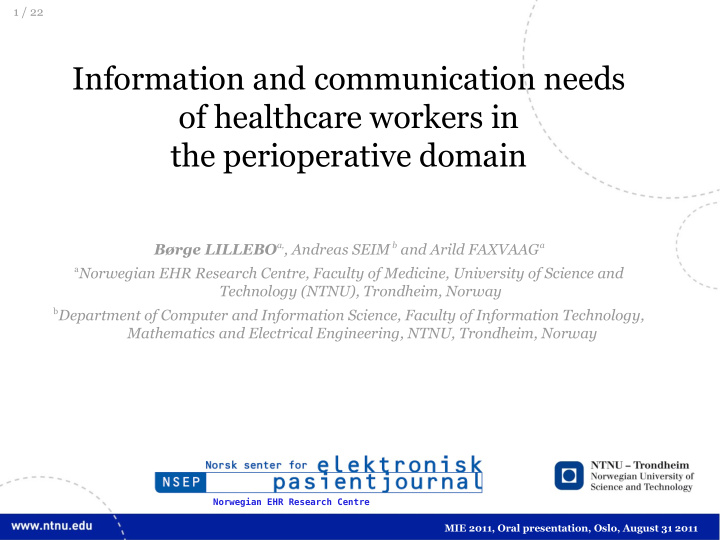



1 / 22 Information and communication needs of healthcare workers in the perioperative domain Børge LILLEBO a, , Andreas SEIM b and Arild FAXVAAG a a Norwegian EHR Research Centre, Faculty of Medicine, University of Science and Technology (NTNU), Trondheim, Norway b Department of Computer and Information Science, Faculty of Information Technology, Mathematics and Electrical Engineering, NTNU, Trondheim, Norway Norwegian EHR Research Centre MIE 2011, Oral presentation, Oslo, August 31 2011
2 / 22 Background MIE 2011, Oral presentation, Oslo, August 31 2011
3 / 22 costt.no MIE 2011, Oral presentation, Oslo, August 31 2011
4 / 22 Methods • Observations and interviews at the surgical unit of a 800-bed university hospital in Norway • 31 interviews with anesthesiologists, cleaners, nurse anesthetists, OR nurses, OR suite coordinators, OR technicians, post-anesthesia care unit nurses, surgeons and ward nurses • Goal-directed task analysis MIE 2011, Oral presentation, Oslo, August 31 2011
5 / 22 Results • Projection of future status • Last minute reminders • Multiple perspectives • Differentiated information requirements MIE 2011, Oral presentation, Oslo, August 31 2011
6 / 22 Projection of future status MIE 2011, Oral presentation, Oslo, August 31 2011
7 / 22 “I have to know when the operation will start in order to do required patient preparations such as fasting, showering and premedication.” - Ward nurse MIE 2011, Oral presentation, Oslo, August 31 2011
8 / 22 “It would have been nice to know in advance approximately when the operations would start. In my case a message one hour before the operation begins would be nice. That would give me enough time to take care of an ED [emergency department] patient in the meantime.” - Surgical resident MIE 2011, Oral presentation, Oslo, August 31 2011
9 / 22 «What matters to us is when the patient is expected to arrive here. It is nice to know that approximately 30 minutes before he comes, because then we have the possibility of sending one of the other patients out if we are full.» - Post-anesthesia care unit nurse MIE 2011, Oral presentation, Oslo, August 31 2011
10 / 22 “Anyway, it is about walking around and looking through the OR windows. I don't know if there is anything particular that I look for, such as the surgeon having finished his work or something like that. But I try to project when each operation will finish and next patient will arrive (...) If I don't keep myself updated, there will be a lot of nagging on my pager” - Operating Room Technician MIE 2011, Oral presentation, Oslo, August 31 2011
11 / 22 Last minute reminders MIE 2011, Oral presentation, Oslo, August 31 2011
12 / 22 “They page me when I have to come to the OR” - Surgeon MIE 2011, Oral presentation, Oslo, August 31 2011
13 / 22 “We know when we should go and wash an operating room the moment they page us. Usually they do that when they are about to transport the patient out of the room. Sometimes they notify us before the patient is out, then we wait or start some minor washing with the patient in the room.” - Cleaner MIE 2011, Oral presentation, Oslo, August 31 2011
14 / 22 “When the patient has recovered sufficiently we call the ward and ask them to come and get the patient.» - Post-anesthesia care unit nurse MIE 2011, Oral presentation, Oslo, August 31 2011
15 / 22 Multiple perspectives MIE 2011, Oral presentation, Oslo, August 31 2011
16 / 22 “I miss simpler tools to control whether or not our plans are feasible - e.g. if a surgeon has been planned to be in two places at the same time.” - Operating Suite Coordinator MIE 2011, Oral presentation, Oslo, August 31 2011
17 / 22 Differentiated information requirements MIE 2011, Oral presentation, Oslo, August 31 2011
18 / 22 Discussion and Conclusion • Limitations: – Our study was limited to perioperative patient handovers at one surgical suite – We presented our informants subjective beliefs about personal benefits from status information and projections • Many actors depended on and/or thought they could benefit from improved situational awareness in perioperative patient care • Information requirements differed considerably • This insight has been a first step into developing and evaluating situational awareness systems for perioperative patient care activities MIE 2011, Oral presentation, Oslo, August 31 2011
19 / 22 Future Work MIE 2011, Oral presentation, Oslo, August 31 2011
20 / 22 MIE 2011, Oral presentation, Oslo, August 31 2011
21 / 22 MIE 2011, Oral presentation, Oslo, August 31 2011
22 / 22 Questions? and hopefully some advice... costt.no Børge Lillebo borge.lillebo@ntnu.no MIE 2011, Oral presentation, Oslo, August 31 2011
Recommend
More recommend